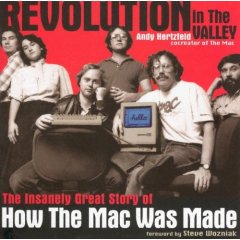Originally
published on Monday, January 1, 2005 in The Miami Herald
Tale of American genius gets to Apple's core.
The
story behind Apple and its widely imitated Macintosh interface sheds
light on the personal computer revolution and American innovation.
BY RICHARD PACHTER
rpachterATwordsonwords.com
Revolution
in the Valley: The Insanely Great Story of How the Mac Was Made.
Andy Hertzfeld. O'Reilly. 291 pages.

It's a poorly kept secret, but we're all using Macintosh computers
right now. Most of them, of course, use microprocessors made by
Intel rather than Apple, and run Microsoft's Windows, not Apple's
OS9 or OSX, but they're all direct descendants of the original graphic
user interface and operating system created by an amazing group
of computer artists in the early 1980s.
The popularity of the nascent Apple II microcomputer began the personal
computer revolution, but that was just the beginning for the upstart
company in Cupertino, Calif.
Author Andy Hertzfeld joined Apple as a young developer and eventually
became a part of the team that was assembled to create the Macintosh,
a revolutionary computer that didn't require arcane keyboard combinations
or other specialized knowledge.
INDUSTRY STANDARD
Its point and click commands, using a metaphoric, icon-driven method
of running software applications and creating documents -- derived
in part from the work of Xerox's seminal interface experiments --
is now the industry standard.
The story of the creation of the Mac is an exciting tale of creativity,
innovation, ego and revolution. It's far more dramatic than one
would expect, and certainly more than just a routine product development
story, as evidenced in Hertzfeld's new book.
Derived from his website, www.folklore.org,
which is an evolving attempt to chronicle the creation of the Mac,
this book is a compilation of a number of stories from the site,
but it's actually much more than that -- and a little less, too.
More, because the book is gorgeous. It's closer to a coffee table
book than a computer-related volume. O'Reilly mostly publishes how-to
manuals and the like, so kudos to them for recognizing that Hertzfeld's
project required special handling.
GREAT PRESENTATION
In addition to his text, the accompanying photos, hand-written notes
and other graphic elements are beautifully presented. Less, because
the hyperlinks on the website are replaced by mere text references
in this book.
Most computer hardware and software developers were and are fairly
anonymous, but the advent of Apple turned founders Steve Jobs and
Steve Wozniak
into household names.
Hertzfeld also limns vivid portraits of many of the colorful characters
on the team, such as Burrell
Smith, Bill
Atkinson and Steve
Capps, as well as others who may have been less flamboyant but
whose contributions to computer design and usability are inestimable.
Susan Kare, for
example, was unknown to me before I read this book, but she created
nearly all of the Mac's
icons and fonts (many with Hertzfeld's help) and later, as an
independent designer, did the same for Microsoft's Windows' icons.
It sounds like a mundane task, but Kare's genius simplified a vital
element that could have been needlessly complicated and did so with
intuitive elegance and appealing functionality.
BUSINESS INSIGHT
There are ample business insights amid the memories. For example,
the tough negotiating of Bill Gates resulted in Microsoft's perpetual
license for the Mac interface, hence Windows' ''resemblance'' to
the Macintosh operating system. And the often-irascible Jobs' early
insistence upon design innovation and excellence is borne out in
the company's current astounding success.
Whether you're a Mac person or a Windows user, this classic tale
of American innovation is entertaining and insightful.
Like business books? Join the club.
|

